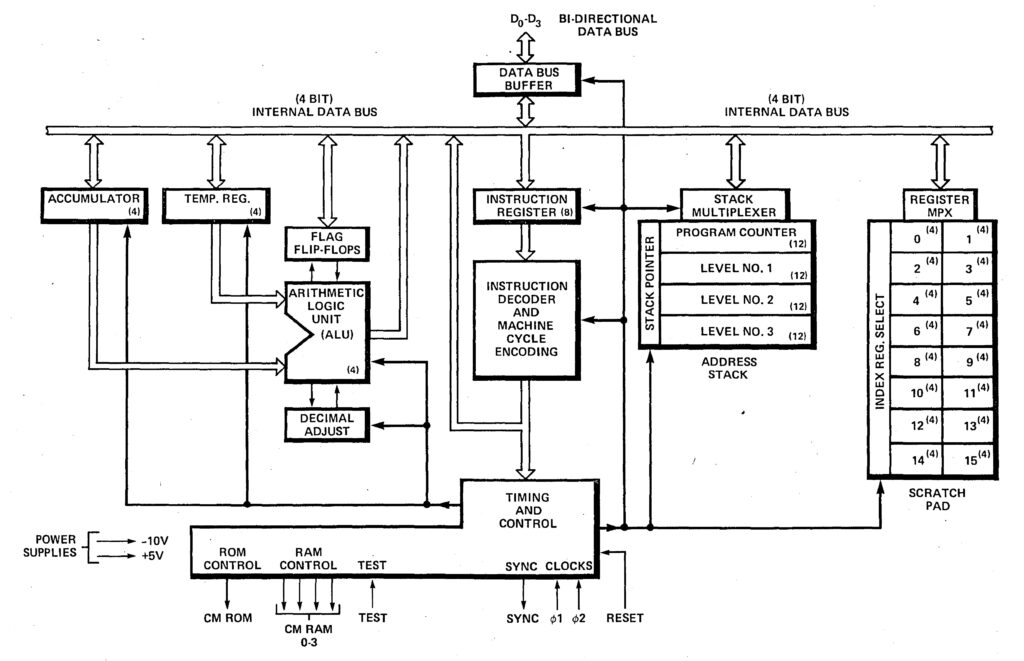- 10.8 Microsecond Instruction Cycle
- CPU Directly Compatible With MCS-4 ROMs and RAMs
- Easy Expansion – One CPU can Directly Drive up to 32,768 Bits of ROM and up to 5120 Bits of RAM
INTEL 40044·BIT P·CHANNEL MICROPROCESSOR
- 4-Bit Parallel CPU With 46 Instructions
- Instruction Set Includes Conditional Branching, Jump to Subroutine and Indirect Fetching
- Binary and Decimal Arithmetic Modes
The Intel® 4004 is a complete 4-bit parallel central processing unit (CPU). The 4004 easily interfaces with keyboards, switches, displays, A-D converters, printers and other peripheral equipment.
The CPU can directly address 4K 8-bit instruction words of program memory and 5120 bits of data storage RAM. Sixteen index registers are provided for temporary data storage_ Up to 16 4-bit input ports and 16 4-bit output ports may also be directly addressed.
The 4004 is fabricated with P-channel silicon gate MOS technology.

The Intel 4004’s historical narrative intertwines with the Busicom calculator story. In the early 1970s, Busicom, a Japanese calculator manufacturer, collaborated with Intel to create a custom microprocessor for their calculators. However, Intel engineer Federico Faggin proposed a more versatile microprocessor design, leading to the birth of the 4004.
Although the collaboration with Busicom ended after the 4004’s design shifted to a more general-purpose architecture, the initial partnership played a crucial role. Busicom’s requirements influenced the microprocessor’s core features, while Intel’s innovation transformed the design into a groundbreaking chip that revolutionized the electronics industry.
The Busicom connection underscores how unexpected turns in technology partnerships can lead to transformative breakthroughs. The convergence of Busicom’s needs and Intel’s vision resulted in the birth of the 4004, an event that not only altered the trajectory of computing but also set the stage for the microprocessor’s expansive journey through history.
As the first commercially available microprocessor, the 4004 was a watershed moment in computing history, initiating the microcomputer revolution. Its success spurred the development of the MCS-4 family of microprocessors, driving innovation in diverse industries. Its introduction marked the transition from specialized hardware to general-purpose computation, democratizing access to computing power.
The 4004’s compact architecture and versatility ignited the personal computer era, transforming how people interact with technology. Its profound impact transcended its time, shaping the trajectory of electronics, telecommunications, and beyond. The 4004’s influence is imprinted on the DNA of modern devices, underscoring its enduring legacy as the cornerstone of the digital age and a testament to human ingenuity in the pursuit of technological progress.
- Intellec-4: The Intellec-4 was an integrated microcomputer system introduced by Intel. It was designed as a development platform for the MCS-4 family of microprocessors, including the 4004. The Intellec-4 provided various tools for programming, debugging, and testing microprocessor-based systems. It featured a keyboard for manual input, a display for output, and the capability to load and execute machine code programs. The Intellec-4’s software included a monitor program, assembler, and simulator, making it an essential tool for software development.
- SIM-4: The SIM-4, short for „Single-Board Microcomputer System,” was another hardware tool provided by Intel for developing software for the 4004 microprocessor. It was a compact single-board system that allowed developers to prototype and test programs without the need for a full computer setup. The SIM-4 included a hexadecimal keypad for input and a display for output. It allowed users to enter machine code instructions directly and see the results on the display, enabling quick experimentation and testing of software.
- The Busicom 141-PF was an early electronic calculator released in 1971. It utilized the Intel 4004 microprocessor, making it one of the first consumer devices to feature a microprocessor. The compact calculator’s significance lies in its role as an inspiration for the development of the Intel 4004, a milestone in the advancement of microprocessor technology.This calculator was historically significant because it played a key role in inspiring the development of the Intel 4004 microprocessor. Busicom had initially approached Intel to design a custom chip for their calculators, but the collaboration led to the creation of a more general-purpose microprocessor that eventually laid the foundation for the microprocessor revolution.The Busicom 141-PF and its association with the Intel 4004 exemplify how the convergence of various technological innovations and partnerships can drive the evolution of computing and electronics.
- The MC404 (Microcomputing System MCS-4 and MCS-40) is now developed on the original integrated circuits from the seventies. The MC404 was designed as a development platform for learning and experimenting with first microprocessors. It was built around the Intel 4004 and Intel 4040 microprocessors.The MC404 featured a 24-key keypad for input, a LED display for output. It came with a calculator program in ROM, which allowed users to check the Intel 4004 processor in action.







